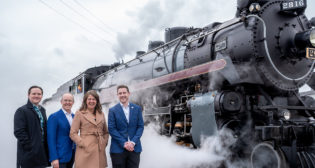
There’s No Such Thing as ‘Resilience Railroading’
Written by Rick Paterson, Managing Director, Loop Capital MarketsWe’ve of course been watching the back and forth between the Ancora group and Norfolk Southern ahead of the May 9 proxy contest. We don’t feel a need to comment on every punch and counterpunch, but one thing that has caught our attention is Ancora’s increasing use of the term “Resilience Railroading” to describe the way Norfolk Southern runs its network, and then attacking it, most notably in Ancora’s March 26 letter to Norfolk Southern shareholders.
There’s no such thing as “Resilience Railroading.” It was just an expression NS CEO Alan Shaw used once when describing a chart during the company’s December 2022 Investor Conference. Here’s why Ancora may want to rethink its use of the term:
Lack of resiliency has been the industry’s Achilles Heel over the past decade. It was a lack of resiliency that contributed to Union Pacific, BNSF, and CSX’s meltdowns in 2014 and 2022; Norfolk Southern’s meltdowns in 2014, 2018 and 2021; Kansas City Southern’s meltdowns in 2014 and 2021, and CN’s meltdown in 2017. Of the 14 Class I meltdowns since the start of 2014, a lack of resiliency—specifically around crew capacity—was a contributing factor in 12 of them. In response to all the chaos, the STB held its “Urgent Issues in Freight Rail Service” hearing in April 2022, where arguably the key finding was the lack of resiliency and key action item was for the industry—not just Norfolk Southern—to fix it. NS has been the most visible in attempting to do so in the context of its public comments.
You can see where we’re going with this. Increasing industry resiliency is absolutely critical, but we’re now in the midst of a high visibility proxy contest where one side is using the word and attaching negative connotations to it. We’ve no doubt the Ancora group also appreciates the criticality of resiliency, but the problem is that a large chunk of the institutional investor audience isn’t going to understand the mechanics and associated nuances of applying strong, but not excessive, resiliency to a Class I rail network. Since April 2022 they’ve been repeatedly (and correctly) told greater resiliency is a positive thing, but now it suddenly represents excess and waste and is to be avoided?
Irrespective of how the proxy contest plays out, what we fear is a situation where a byproduct of it is “resilience railroading” entering the Wall Street lexicon, and we end up with all the Class I’s at various points in the future accused of running a resilience-railroading operation and then being pressured by the investment community to instead run leaner‑which invariably means fewer people, and more specifically, fewer train crews. In that perverse scenario we never get out of Meltdown Hell, rail industry loadings and market share will continue to shrink, and the end game for the stocks is boring dividend yield plays.



